Bobby Flay's 10 Most Important Tips For Making Pasta
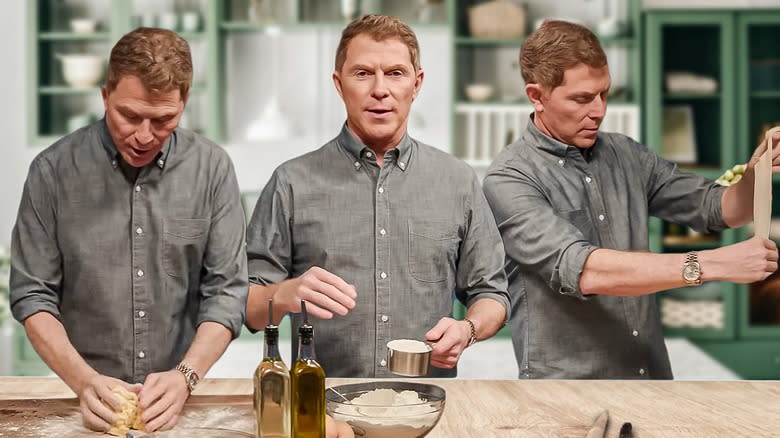
- Oops!Something went wrong.Please try again later.
Bobby Flay has mastered the art of creating some of the most exquisite dishes seen on television and sampled in American restaurants. When one hears that he was trained at New York's French Culinary Institute, now known as the International Culinary Center, one might automatically think of lofty soufflés or servings of coq au vin. But while we can appreciate the culinary virtuosity of some of Flay's more complex dishes, his expertise in making elevated pasta meals really stands out, and is what home chefs might find most useful as a model for their daily kitchen machinations. This means that when you take inspiration from Flay ahead of your next pasta adventure, you can say goodbye to bland flavor and mealy texture, and start to experience the symphony of aromas that his pasta dishes embody.
Indeed, Flay's approach to pasta is marked by a perfect blend of tradition and innovation, as well as a balancing act between simplicity (which pasta demands) and sophistication (which taste buds demand). So, Flay won't steer you wrong — whether making the perfect pasta dish simply requires swapping your regular oil, using a specific type of sauce, or employing your kitchen tools in new and exciting ways. Let's take a look at some of the most important tips Bobby Flay has for making pasta, as seen in previous Tasting Table articles or on his Instagram page.
Read more: Ina Garten's 12 Best Cleaning Tips For A Mess-Free Kitchen
Use Chunky Tomato Sauce
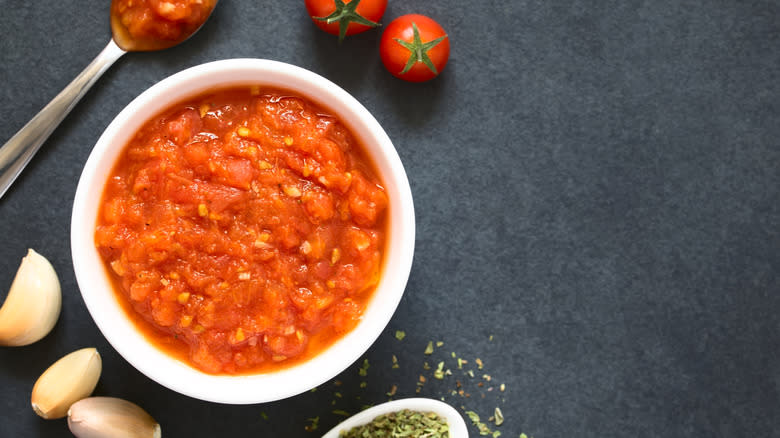
When making pasta, texture can sometimes be even more important than flavor. Not for nothing, al dente is widely considered the most desirable cooking level for your pasta — not because it has any direct bearing on flavor, but because the chewy texture is essential to the success of the dish. Mealy pasta just doesn't hold the sauce as well, not to mention the fact that its flimsy texture might distract you from the flavors that are swirling around your mouth as you take each bite.
Bobby Flay opts for a chunky tomato sauce for pasta to create good texture. He recommends using a can of whole peeled San Marzano tomatoes, and crushing them with a potato masher — the uneven results of this method will give your sauce a sort of homemade charm you wouldn't get with the pureed smoothness inevitably yielded by a food processor, or with canned diced tomatoes, for that matter. This allows the resulting sauce to break down while still retaining some of that chunkiness in parts. The key is to not overcook this concoction — 30 minutes is plenty of time, or you might end up with a smoothed out sauce despite your best efforts not to. Other than that, just add some olive oil, salt, and Parmesan, and your job is done. Serve it with penne, rigatoni, or another small pasta type with lots of crannies, which are best at keeping the sauce in place.
Make It Crunchy
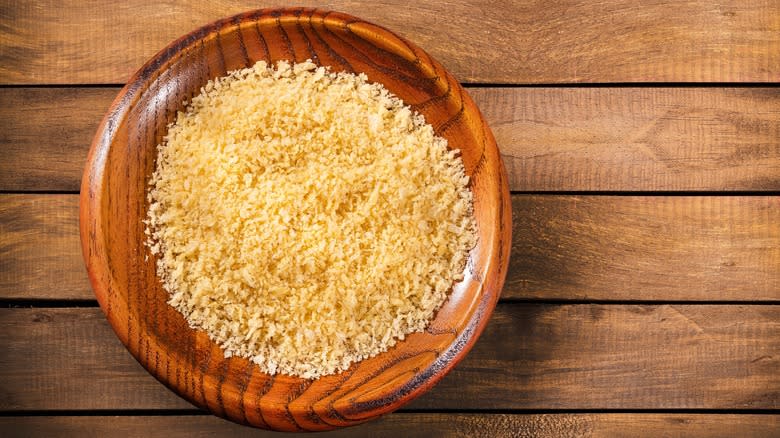
Of all the Italian dishes that have made it to this side of the pond, pasta might be one of the most famous ... along with pizza, of course. But pasta comes in many variations, and although Americans are by now well acquainted with some of them, such as Bolognese or marinara, there is one Italian pasta hack that hasn't quite achieved the same level of fame in American kitchens.
Luckily, we now know the ingredient Bobby Flay adds to pasta for a bit of crunch. Adding breadcrumbs to pasta is a delightful trick that can be used with pretty much any type of pasta dish, but it excels the most when it is applied to simple spaghetti dishes, like aglio e olio, where the breadcrumbs can glom onto the pasta and create a standout texture throughout. To emulate Flay's breadcrumb rule, use panko and toast it briefly with some butter, minced garlic, salt, pepper, and lemon zest before applying it to your pasta. This can be done quickly as your water boils, or even several days in advance. Then just sprinkle the breadcrumbs on top of your pasta, or stir them in for a more even distribution.
Opt For Avocado Oil
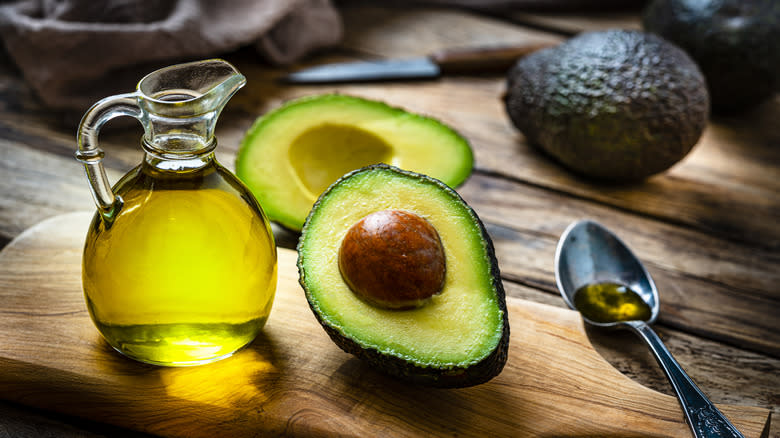
Many people tend to use some version of olive oil when engaging in Italian cooking. This makes sense, as it may be one of Italy's most beloved exports, and if it's good quality, olive oil tastes delicious. But when we see that Bobby Flay uses avocado oil when cooking pasta sauce, it's best not to dismiss him outright, as he may have a point.
In fact, he has two good points. First, avocado oil is more neutral in flavor than olive oil, which means it will affect the overall flavor of the sauce less than olive oil, letting the other ingredients stand out more. Second, it has a higher smoke point than olive oil, which makes it harder to burn your sautéed garlic, as the temperature required for that is increased. So, if you have a friend who consistently burns their pasta sauces (or anything they cook, for that matter), consider giving them a bottle of avocado oil as a birthday present. And then tell them they can thank Bobby Flay for their massively improved cooking skills.
Add Sugar To Tomato Sauce If Necessary
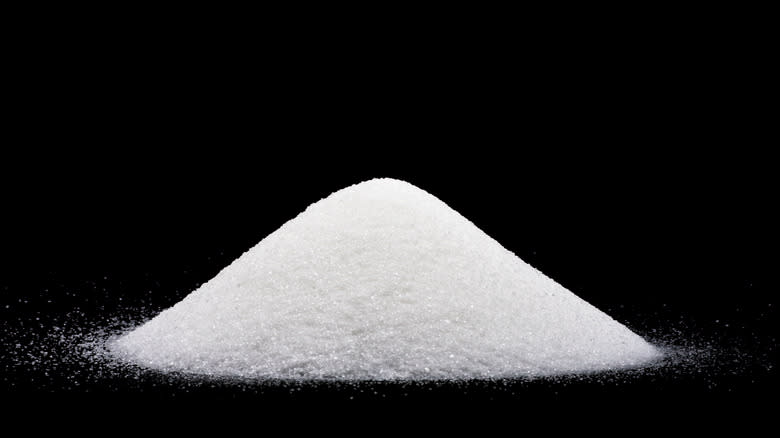
It may seem counterintuitive to add sugar to a tomato product. Tomatoes tend to be used for savory applications like sauces and soups, and sugar is more of a dessert ingredient. But actually, sugar can lower our perceptions of sourness due to the natural acidity present in tomatoes. This is why Bobby Flay is not averse to adding the sweet ingredient when he weighed in on the sugar in tomato sauce debate, explaining that he adds a touch of sugar to his tomato sauces every so often, depending on how acidic the tomatoes turn out to be.
Just make sure you take it easy on the sugar, as you don't want the sauce to actually taste sweet. It's just there to balance out the acidity of the tomatoes while bringing out their flavor. Also, don't get too trigger happy with the sugar, as there is a chance you may never actually need it. If you select sweeter tomatoes to begin with, like San Marzanos, adding sugar will just become redundant and may even make your sauce way too sweet. Moreover, you don't want to get rid of the acidity altogether — after all, that tartness is part of what makes a tomato so delicious, and eliminating that level of flavor could lead to a bland dish.
Don't Forget The Anchovies
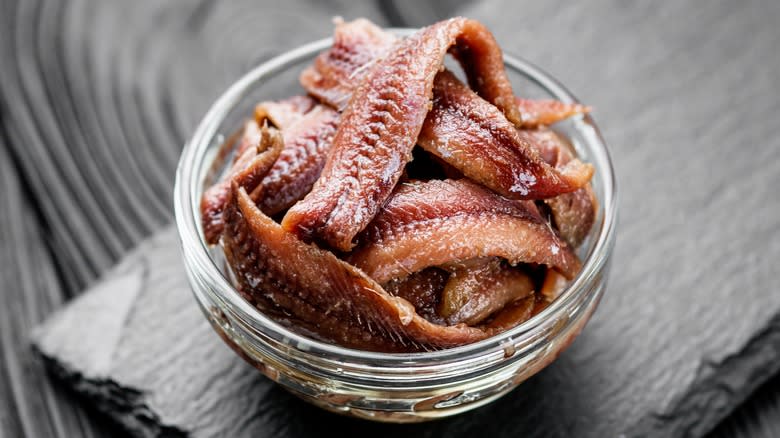
You might be surprised to find out just how many chefs sneak anchovies into their cooking, even in dishes that don't look or taste like they may contain fish of any kind. Giada De Laurentiis is one celebrity chef who has clearly expressed her reverence for anchovies, and Bobby Flay considers them as a secret ingredient he puts in almost everything.
But you wouldn't necessarily know this by tasting his dishes, and that's the point. When you use anchovies in a pasta sauce, the little fish all but dissolve into the liquid, leaving behind nothing but flavor. For example, anchovies are melted down into a sauce with olive oil and cherry tomatoes to make pasta puttanesca — and it gets a deeper taste by doubling the anchovies. To use these nifty little fish in your own way, though, just add them to your sauté for a bit of umami, or even as a replacement for salt. You could also cook anchovies in boiling pasta water and pair them with butter, a little trick Flay picked up in Italy while filming a show with the other aforementioned anchovy lover, De Laurentiis.
Enlist A Food Processor For Fresh Pasta
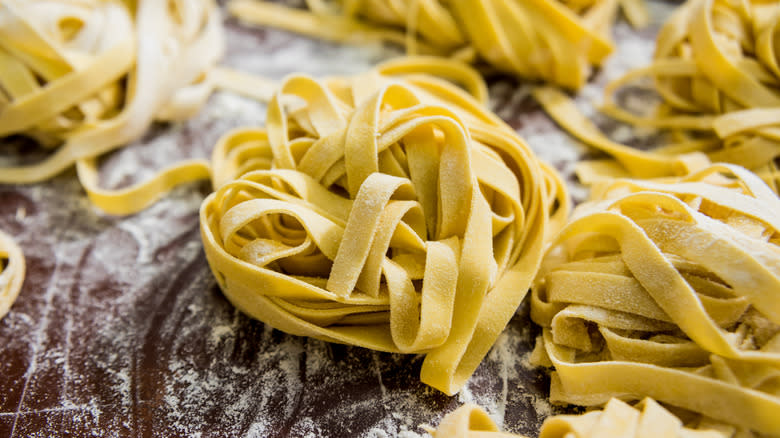
It's hard to imagine what kitchen life was like before the advent of food processors. Believe it or not, there was a time when if we wanted something broken down into tiny bits, we had to whip out a mortar and pestle and just mash it ourselves, by hand. This method even gave its name to a famous sauce we all know and love: pesto, which takes its name from the Italian verb for pounding into a pulp. Today, pesto is one of those foods that is usually made in a food processor, thankfully.
But another thing you can make in a food processor, which might surprise you, is fresh pasta dough. At least, that's what Bobby Flay does for his fresh pasta, as he demonstrated in a Food Network post on X, formerly known as Twitter. He tosses in flour, eggs, and egg yolks, and blitzes everything until thoroughly blended, something which could take some 15 minutes of kneading by hand. Instead, now you can use those 15 minutes to let the dough rest, giving it a chance to develop the gluten it'll need to hold together once plopped in the boiling water. After that, just knead the dough for a few seconds and slip it in the pasta roller. Once you've done this, you'll realize that fresh pasta is not unattainable, and that in fact — barring those 15 minutes of resting time during which you can be doing something else — it might even be faster to prepare than dried pasta, which typically takes longer to cook.
Don't Snub A Good Pre-Made Sauce
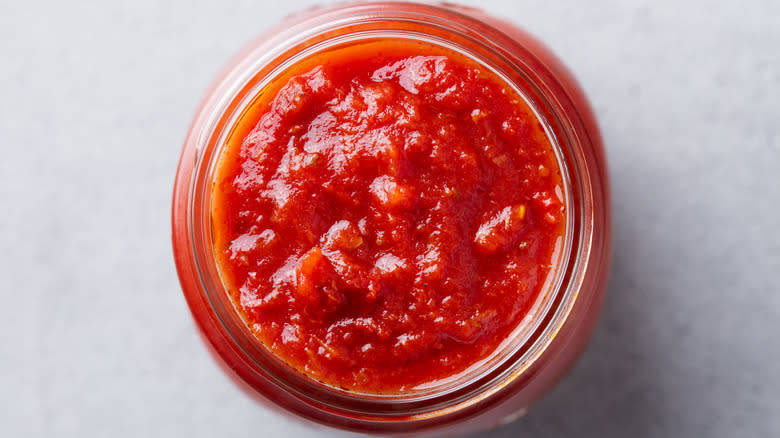
Time management is a big challenge for most people. We get to the end of the workday and realize we don't have time to stop at the grocery store before picking up the kids, who have soccer practice and violin lessons, which means that by the time you get home, there won't be anything to eat except plain pasta — with butter, if you're lucky.
This is where Bobby Flay comes to the rescue, recommending that you don't snub pre-made pasta sauce, especially on busy nights. In particular, Flay uses a pre-made sauce called Simply Sugo, as we learned when he bared his pantry to the world in an Instagram post last year. This sauce, made by Italian canned-tomato powerhouse Mutti, contains high-quality ingredients, but mostly it just contains good tomatoes and good seasoning. As Flay mentioned in the post, he just pops open a jar and doctors it up with choice herbs to make a quick and easy pasta sauce. There's nothing stopping you from doing the same. And while Flay says he uses oregano, Calabrian chilies, and fresh basil, feel free to experiment with your own favorite spices and herbs.
Add Pasta Water To Your Sauce
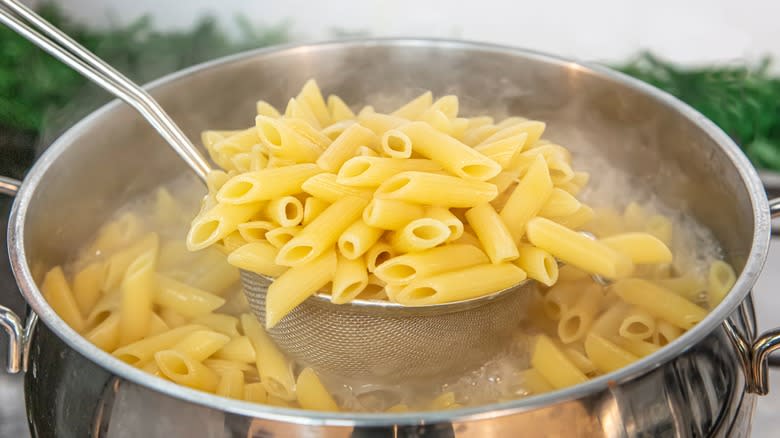
Creating a perfectly creamy sauce for your pasta is no easy feat, especially if you didn't know about the trick of reserving some of the water that you use to boil the pasta and adding it to your pot of sauce. As Bobby Flay said in a recent Instagram post, he saves the pasta water "because it already has that starchiness to the water itself" that comes from the gluten in the pasta. He goes on to explain that this is "a really good way to thin out a sauce, giving it good sauce consistency, but also it helps the sauce stick to the pasta."
In his post, he demonstrates how to use this trick with a sauce made with fresh cherry tomatoes, which he sautées in a pan, cooking them slightly before adding pre-cooked pasta and some of its water. The pasta water helps bind all the ingredients together while deglazing the pan. But you can use this trick in any type of sauce you're making, especially at the point where it's starting to get a little too thick. The starchy water helps thin it out without making it too watery.
Blister The Cherry Tomatoes First
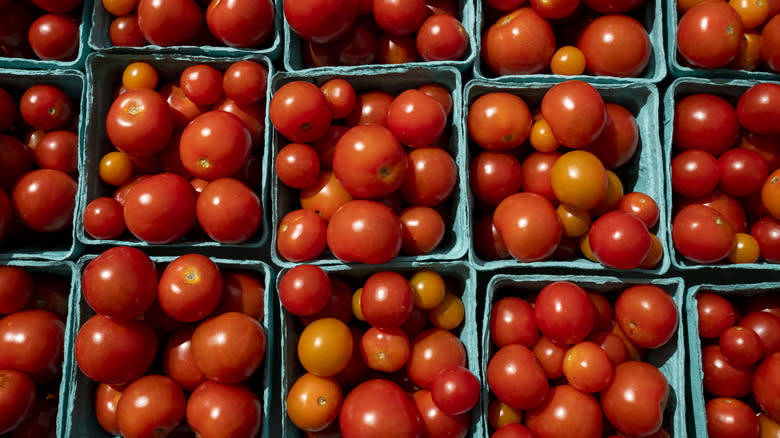
Making tomato sauce from canned tomatoes might be the more traditional route, but that doesn't mean you can't use fresh tomatoes. In fact, in the same Instagram post that he shared to encourage adding pasta water to sauce, Bobby Flay used very ripe yellow and red cherry tomatoes to put together a fresh, light, and all-around delicious tomato sauce. Although you can carry out this recipe with any type of tomatoes, Flay chose cherry tomatoes because they tend to be sweet even in the off-season, with "a beautiful tomatoey, sweet flavor to them."
The trick is to cut the cherry tomatoes in half and blister them in the pan with olive oil, as Flay explains, in order to get those "natural tomato juices [to] spill out." This basically causes them to make their own sauce, which then blends in with the pasta water Flay later adds to the pan. Although this recipe shouldn't take too long, as you don't want to overcook the tomatoes and cancel out their freshness, you do want to make sure you let them become nice and soft, allowing them to better blend in with the rest of the ingredients.
Use Orecchiette To Highlight The Sauce
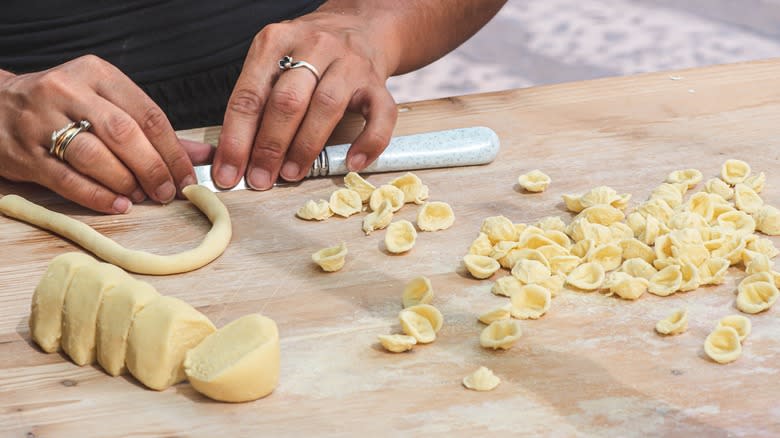
When you've made a really beautiful sauce and you want everyone to taste how far you've come in the kitchen, grab some orecchiette off your shelf and put the sauce on that pasta. In a recent Instagram post, Bobby Flay called these charming little round delights "the scoops of pasta" because they literally scoop up your sauce and keep it in a little well. So when you bite into orecchiette filled with sauce to the brim, you'll get bursts of flavor.
While this principle can be applied to any type of sauce that you want to savor to the max, Flay illustrates it with a cherry tomato, ricotta, and asparagus orecchiette recipe. He starts by seasoning that ricotta, which will later curl up into the nooks formed by the orecchiette, before going on to make the cherry tomato sauce, which will also make its way into those dainty little pasta scoops. If you play your cards right, you might even find some pieces of the blanched asparagus hiding away with the tomatoes and ricotta. That is the beauty and mystery of orecchiette.
Read the original article on Tasting Table.

